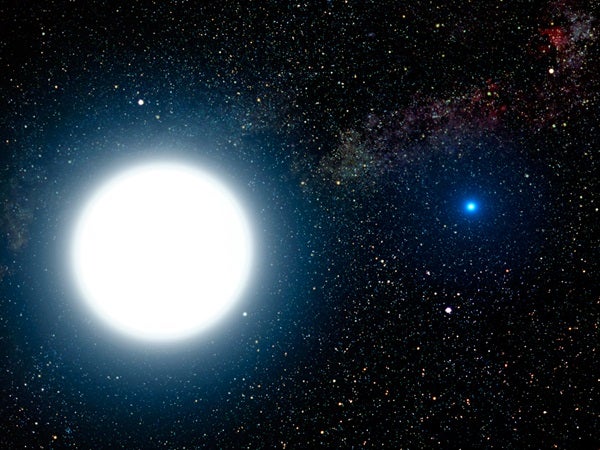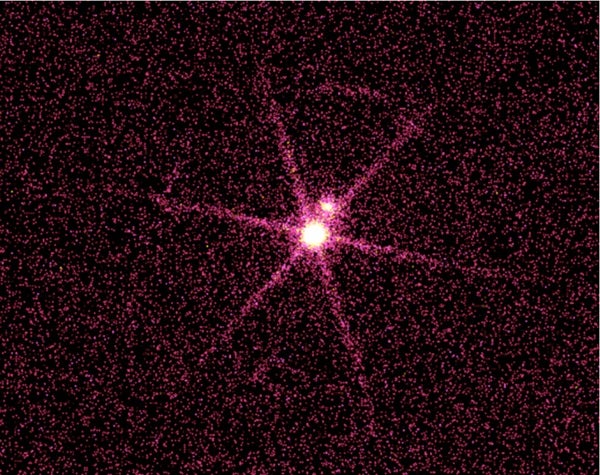We are all prisoners of our background and experience. What each of us considers normal is based on our lifelong encounters. The materials we relate to and find familiar range from the thinness of mountain air to the high density of iron, as in trying to budge the anchor of a friend’s boat. Rarely do we venture outside this envelope and encounter Earth’s highest-density elements, which are twice iron’s weight. How many of us have ever been asked to lift a bucket of lead pellets or had the unlikely fun of hefting a bar of gold?
The “standard” for assessing density is water, the most common compound in the cosmos. An aquarium full of water measuring 1 foot (30.5 centimeters) in each dimension weighs 62.4 pounds (28.3 kilograms), which is not easy to tote. A sugar-cube volume of water — one cubic centimeter — weighs precisely 1 gram, or 1/28 ounce.

Bringing the universe to your door. We’re excited to announce Astronomy magazine’s new Space and Beyond subscription box – a quarterly adventure, curated with an astronomy-themed collection in every box. Learn More >>.
Stars like our Sun have the same overall density as water or slightly more. But when a star collapses in its old age and its material increasingly compresses, the result is a brilliant white sphere with headline-making density.
Any star that weighs between half the Sun’s mass and about 1.4 solar masses — the vast majority of stars in the universe — ultimately uses up its nuclear fuel and collapses in a predictable way that does not result in a supernova explosion. During a star’s AARP years, the normal hydrogen-into-helium fusion process gets replaced by helium “burning,” which creates carbon and oxygen.
When a sun exhausts its nuclear fuel and its furnace sputters to a stop, gravity collapses it. The sun stops imploding because quantum mechanics says that each subatomic particle needs a bit of elbowroom. This so-called “electron degeneracy pressure” halts the shrinkage — but not before the star has become very small and very strange.
This is where we rewind to the late 18th century, when German-born British astronomer William Herschel found the triple star system 40 Eridani (also known as Omicron2 [ο2] Eridani) in 1783, soon after he discovered Uranus. This triplet, easily resolved through small telescopes, contains a dim red, a dim white, and a brighter yellow star. By 1910, astronomers realized that the “dim white” member — unimaginatively named “40 Eridani B” — must be extremely tiny.
Earlier, in 1844, wobbles in the motion of the Dog Star Sirius had led famed German astronomer Friedrich Bessel to conclude that an unseen companion tugged at it. Nearly 20 years later, on January 31, 1862, the world’s premier telescope maker, Alvan Clark, confirmed this. While testing out his latest instrument, an 18.5-inch refractor that was the largest in the U.S., Clark saw a faint 8.5-magnitude dot next to the dazzle of Sirius, in the position predicted by Bessel. It was soon named Sirius B but is often called “the Pup” because it accompanies the Dog.
The fact that 40 Eridani B is drastically subluminous and thus extremely tiny was recognized in 1910, and five years later, astronomers acknowledged Sirius B as belonging in the same Lilliputian category. Willem Luyten first used the term white dwarf to describe them both in 1922.
Thanks to their binary system memberships, scientists have precisely determined the weights of both Sirius and the Pup. Older references said the Pup had 98 percent of our Sun’s mass, but newer measurements place it at an odd and interesting 100 percent on the nose.
In 2005, its diameter was very accurately measured, too — 7,500 miles (12,070 kilometers), which is a scant 400 miles (640km) smaller than our planet. Packing the Sun’s enormous mass into a tiny Earth-sized ball means the matter in Sirius B is nearly 100,000 times denser than iron. A sample of this white dwarf’s material the size of a deck of cards would outweigh 10 cement trucks. Sirius B has such fierce gravity that it actually bends light.
So Sirius B matches our Sun’s weight and Earth’s size. Very cool indeed. Especially given the fact that — of the 9,000 white dwarfs we have now identified — the Pup is the nearest. But it’s actually slightly unusual because most white dwarfs have two-thirds the Sun’s mass. Sirius B is rather a heavyweight.
Their very oval 50-year orbit makes Sirius and the Pup slowly alter their physical separation, as we see it, from about the Sun-Saturn distance to the Sun-Neptune gap. Happily for backyard astronomers, the widest gap will present itself in seven years. The angular separation will grow from the impossible 2.5 arcseconds it displayed in 1993 to a much easier 11 arcseconds (one-fourth the apparent width of Jupiter) coming up in 2022.
It’s always been fun to imagine Sirius B, the very nearest white dwarf. Now we’ll soon be able to see it, too. But we can never move the spotlight too far away from 40 Eridani B. Though twice the Pup’s distance, at 16½ light-years, it remains far and away the only white dwarf that is truly easy to see through inexpensive backyard telescopes. And it will never lose its status as the very first to be observed and recognized — for the marvel that it is.











